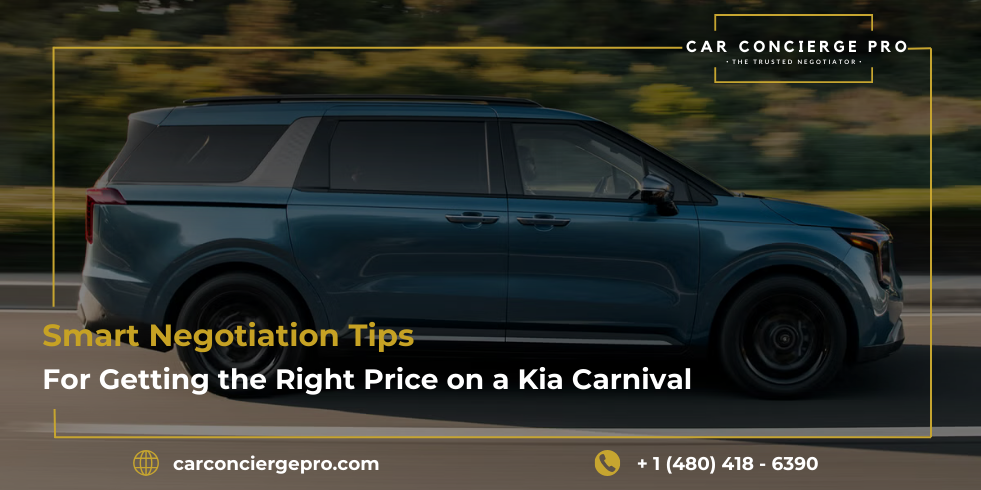Buying a Kia Carnival is a major investment, and getting the right price requires more than just walking into a showroom. Whether you’re upgrading your family vehicle or investing in a luxury MPV, negotiation can save you thousands of dollars. In this guide, we’ll break down actionable tips that help you secure the best possible deal. From understanding market trends to leveraging discounts and financing, we cover every step to make your Kia Carnival purchase smooth and budget-friendly.
- Learn how to spot hidden dealer incentives and seasonal promotions that can drastically reduce your price.
- Discover negotiation strategies that turn test drives and feature inspections into bargaining power.
- Understand how trade-ins and financing options can work in your favor to save thousands.
- Gain insider tips on timing your purchase for maximum discounts, including end-of-month and model changeover periods.
- Explore ways to evaluate the true value of different trims and optional features before committing.
- Avoid common pitfalls that often cost buyers extra money, like hidden fees and rushed decisions.
Table of Contents
ToggleWhy Negotiation Matters When Buying a Kia Carnival
Negotiation isn’t just about haggling for a lower price; it’s about maximizing value. Dealers often have room for discounts, incentives, or add-ons that buyers overlook. Smart negotiation ensures you pay a fair price without compromising features or financing options.
Effective negotiation also builds confidence and prevents buyer’s remorse. By being informed and prepared, you can make decisions based on facts rather than emotions. This approach helps you secure a deal that aligns with your budget while still getting the features and benefits you want in your Kia Carnival.
Research Before You Negotiate
Know the Market Price
Begin by researching the official MSRP of the Kia Carnival in your region and compare it with prices listed on online platforms. Car aggregator websites, dealership portals, and automotive forums can provide insight into what other buyers are paying. This knowledge gives you a strong foundation for negotiation and prevents overpaying.
Compare Multiple Dealers
Visiting and comparing multiple dealerships helps you gauge competitive pricing and available incentives. Dealers are more likely to provide better offers when they know you have alternatives. This approach maximizes your bargaining power and ensures you get the best deal possible.
Understand Seasonal Offers and Discounts
Automakers often provide promotions during festivals, year-end sales, or when new models are launched. Awareness of these periods allows you to plan your purchase strategically. Taking advantage of seasonal offers can significantly lower your purchase price or add extra benefits.
Setting Your Budget and Target Price
Calculate Affordability
Before negotiating, carefully assess your budget to determine how much you can comfortably spend without compromising other financial obligations. Factor in additional costs such as insurance premiums, registration fees, fuel, and regular maintenance. Considering all these expenses gives you a realistic picture of the total cost of ownership. This ensures you don’t overextend financially and can negotiate confidently within your means.
Decide Your Maximum Offer
Establish a firm ceiling price before entering negotiations to prevent emotional decision-making or overspending. This maximum offer should be based on your research of market prices, vehicle condition, and any incentives available. Knowing your limit gives you leverage and helps maintain discipline during discussions with the dealer. It also allows you to walk away confidently if the seller cannot meet your terms.
Timing Your Purchase
Best Times of the Month and Year
Dealerships frequently have monthly or quarterly sales targets to meet, which can make them more willing to negotiate near the end of these periods. Visiting during the last few days of the month, quarter, or year increases your chances of receiving better deals or added perks. Seasonal sales events, like year-end clearance or holiday promotions, can also work in your favor. Timing your visit strategically ensures you maximize potential savings.
Leveraging New Model Launches
When a new Kia Carnival model is launched, dealerships often want to clear out older inventory to make room for new stock. This creates an excellent opportunity to negotiate discounts, free upgrades, or bonus incentives on the outgoing model. Fully loaded models from the previous year may be available at a significantly reduced price. Being aware of new releases allows you to take advantage of these timing-based savings.
Effective Communication Techniques
Be Polite but Firm
Maintaining a respectful tone during negotiations helps build rapport with the salesperson. A friendly yet firm approach signals that you are serious but reasonable. Aggressive or confrontational tactics can backfire and reduce flexibility. Politeness combined with confidence often results in better offers and smoother interactions.
Ask Open-Ended Questions
Using open-ended questions like “What promotions are available today?” or “Are there any incentives I might qualify for?” encourages the dealer to share more information. This approach can uncover hidden discounts, bonus packages, or financing perks. It also positions you as an informed buyer who is actively evaluating options. Thoughtful questioning can give you valuable leverage in the negotiation.
Silence Can Be a Powerful Tool
After presenting an offer, pause and let the salesperson respond without immediately filling the silence. Silence often motivates them to improve the deal or offer additional perks. It demonstrates patience and confidence, showing you are willing to walk away if necessary. Using this tactic strategically can increase your chances of securing a better price or added benefits.
Using Incentives and Offers to Your Advantage
Manufacturer Discounts
Check Kia’s official website for rebates, cash-back offers, or seasonal promotions before visiting the dealership. These manufacturer incentives can often be combined with dealer discounts to maximize your savings. Be sure to verify eligibility criteria, such as specific trim levels or financing options. Staying informed about current offers gives you an edge in negotiations and can lower your overall cost significantly.
Dealer Incentives
Dealers often run promotions like free accessories, extended warranties, or cash-back offers to attract buyers. Always ask about current incentives and factor them into your negotiation strategy. Understanding these perks can increase the overall value of your purchase without raising your out-of-pocket cost. Using incentives wisely can make a significant difference in your final deal.
Trade-In Value
If you have a vehicle to trade in, research its fair market value using tools like Kelley Blue Book or Edmunds. A well-priced trade-in can substantially reduce your total purchase cost. Make sure to get multiple appraisals and negotiate the trade-in value separately from your new car price. Proper preparation ensures you maximize the benefit of your trade-in during the deal.
Test Drives and Vehicle Inspection
Spot Hidden Costs
During a test drive, carefully check for imperfections, unusual noises, or mechanical issues that may not be immediately visible. Look at tires, brakes, suspension, and electronics for signs of wear. Noting these issues gives you concrete points to negotiate a lower price. Being thorough can save you from unexpected repair costs after purchase.
Use Vehicle Features as Negotiation Points
Pay attention to optional features such as leather seats, sunroof, upgraded audio, or advanced safety technologies. Highlighting these during negotiation can help you secure package deals or add-ons without increasing the overall cost. It also shows the dealer that you are knowledgeable about the car’s value. Leveraging features strategically can result in a more satisfying deal.
Negotiating Financing and Payment Terms
Understanding Loan Options
Dealer financing can be convenient, but it isn’t always the most cost-effective choice. Compare interest rates and terms with banks, credit unions, or online lenders to find the best deal. Doing your homework ensures you secure a loan that fits your budget and minimizes overall interest payments.
Down Payments and Interest Rates
Making a higher down payment can significantly reduce your total interest costs over the life of the loan. Focus on negotiating the lowest possible interest rate rather than just concentrating on monthly payments. A smart combination of down payment and favorable interest rate can save you thousands in the long run.
Leasing vs Buying
Leasing a vehicle often results in lower monthly payments and may include maintenance perks, but ownership is limited at the end of the lease term. Buying a car usually costs more upfront but provides long-term value and the freedom to keep or sell the vehicle anytime. Carefully evaluate your driving habits, budget, and financial goals before deciding which option aligns best with your plan.
Common Pitfalls to Avoid
Avoid Showing Desperation
Keep your excitement and eagerness in check during negotiations. Dealers can spot when a buyer is overly enthusiastic and may use it as leverage to hold firm on pricing. Maintaining a calm and composed demeanor gives you more negotiating power and prevents overpaying.
Don’t Rush Decisions
Take your time to carefully evaluate all offers and compare them with market values. Rushing can lead to accepting a price that is higher than necessary or missing hidden costs. Patience allows you to consider trade-ins, financing options, and potential incentives for a better overall deal.
Watch for Hidden Fees
Be aware of extra charges like registration, documentation, dealer handling fees, or optional add-ons. Ask the dealer to provide a complete breakdown of all costs before signing anything. Clarifying fees upfront helps avoid surprises and ensures your budget aligns with the actual purchase price.
Mini Summary: Key Steps to a Successful Negotiation
Successfully negotiating the price of your Kia Carnival starts with thorough preparation. Begin by researching market prices, dealer offers, and available incentives. Set a clear budget, determine your maximum offer, and plan your purchase timing strategically to take advantage of discounts or seasonal promotions.
During the negotiation, communicate politely, ask thoughtful questions, and use silence to your advantage. Leverage trade-ins, financing options, and inspection findings to strengthen your position. Take a test drive to identify potential negotiation points and avoid rushing or showing desperation. Following these steps ensures you can secure a deal that fits your budget while maximizing value.
Conclusion
Negotiating the right price for a Kia Carnival isn’t just about paying less—it’s about getting maximum value while staying within your budget. With proper research, strategic timing, smart communication, and awareness of incentives, you can secure a deal that satisfies both your wallet and your expectations. Remember, preparation is key, and patience can pay off with significant savings.
Additionally, understanding your priorities—whether it’s comfort, features, or long-term reliability—helps guide your negotiation strategy. By being informed about trim differences, market trends, and financing options, you can make confident decisions. Ultimately, a well-prepared approach ensures that your Kia Carnival purchase is both rewarding and stress-free.
FAQs
Q1: How much can I typically save when negotiating a Kia Carnival?
Savings depend on the dealer, region, and timing, but effective negotiation can reduce the price by 5–10%. You may also receive additional perks like free accessories or extended warranties. Being informed about market prices strengthens your bargaining power.
Q2: Is it better to buy or lease a Kia Carnival?
Buying provides long-term ownership and potential resale value, while leasing often offers lower monthly payments. Consider your financial goals, expected usage, and how long you plan to keep the vehicle. Each option has advantages depending on your lifestyle.
Q3: What’s the best time to negotiate a Kia Carnival deal?
End-of-month, end-of-quarter, or during festive and year-end sales typically offer the best discounts. Dealers are often more willing to negotiate to meet sales targets. Planning your purchase around these periods can save you money.
Q4: Can trade-ins help lower the price of a Kia Carnival?
Yes, a fair trade-in can reduce your out-of-pocket cost significantly. Combining a trade-in with dealer or manufacturer promotions can maximize your savings. Always get your trade-in appraised to ensure you receive a fair value.
Q5: Are there hidden fees to watch for when buying a Kia Carnival?
Yes, be aware of registration, documentation, and dealer handling fees. Always ask the dealer to provide a full breakdown of all charges before signing the contract. This prevents surprises and helps you budget accurately.
Q6: Should I get a pre-purchase inspection before buying a used Kia Carnival?
Absolutely. A pre-purchase inspection by a trusted mechanic can uncover mechanical issues or hidden damage. It gives you leverage for negotiation and ensures you avoid costly repairs after purchase.
Q7: How can I make my Kia Carnival negotiation more effective?
Do thorough research on market prices, trims, and optional features before visiting the dealer. Highlight any comparable listings or inspection findings during negotiation. Staying calm, patient, and informed usually leads to the best deal.




 and Canada
and Canada 




